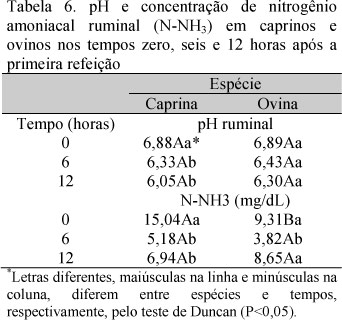With the increase of the sugar and alcohol industries, alternative uses for residue are sought, and the small ruminants from the naturalized breeds of northeastern Brazil are potential groups to make use of the sugarcane bagasse (SCB) in their diets. In this context, the objective was to determine the in situ degradability of dry matter (DM) and neutral detergent fiber (NDF) of SCB and ruminal parameters in Moxotó goats and Morada Nova sheep rumen fistulated. Three grams of SCB were placed in naylon bags and incubated in the rumen at 6, 24 and 96 hours, and the residues analyzed for DM and NDF. Rumen fluid was collected at zero, 6 and 12 hours after the first meal and pH and ammonia nitrogen (N-NH3) were determined. DMI did not differ between goats and sheep. The maximum degradation potential of DM was similar between species and the A of NDF was higher in goats. Sheep had higher colonization time, rate of degradation and effective degradability of DM and NDF. The pH did not differ between species. The highest concentration of ruminal N-NH3in goats was at time zero. Given the higher rate of degradation of bagasse dry matter by sheep, this specie shows a more efficient rumen microbial growth on SCB.
fiber; residue; rumen; goat; sheep








